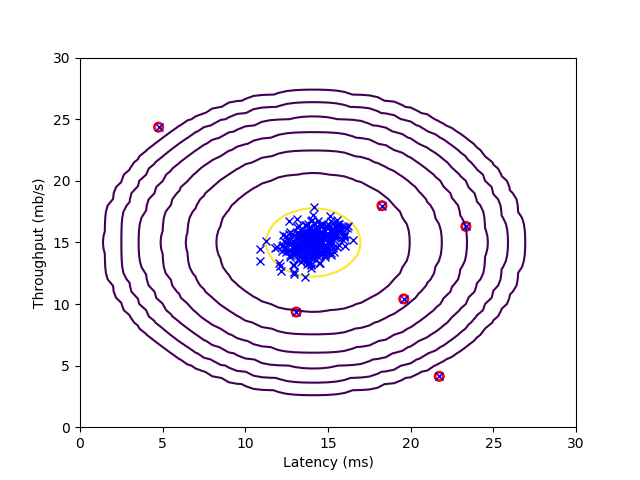Anomaly Detection
Example
- Fraud detection:
- $x^{(i)}=$features of user $i$’s activities
- Model $p(x)$ from data
- Identify unusual users by checking which have $p(x) < \epsilon$
- Manufacturing
- Monitoring computers in a data center
Gaussian distribution
parameter estimation
Dataset: ${ x^{(1)},x^{(2)},\dots,x^{(m)} } \quad x^{(i)} \in \mathbb R$
we want to know $\mu, \sigma^2$
Algorithm
- Choose features $x_i$ that you think might be indicative of anomalous examples.
-
Fit examples $\mu_1,\dots,\mu_n,\sigma_1^2,\dots,\sigma_n^2$
- Given new example $x$, compute $p(x)$:
Anomaly if $p(x) < \epsilon$
Developing and evaluating anomaly detection system
Aircraft engines motivating example
- 10000 good(normal) engines
-
20 flawed engines
- Always
- Training set:6000 good engines
- CV:2000 good engines($y=0$),10 anomalous($y=1$)
- Test:2000 good engines($y=0$),10 anomalous($y=1$)
- Alternative:
- Training set:6000 good engines
- CV:4000 good engines($y=0$),10 anomalous($y=1$)
- Test:4000 good engines($y=0$),10 anomalous($y=1$)
Algorithm evaluation
- Fit model $p(x)$ on training set ${ x^{(1)},\dots,x^{(m)} }$
-
On a cross validation/test example $x$, predict
- Possible evaluation metrics:
- True positive, false positive, false negative, true negative
- Precision/Recall
- $F_1$ score
- Can alse use cross validation set to choose parameter $\epsilon$
Anomaly detection vs. supervised learning
| Anomaly detection | Supervised learning |
|---|---|
| Very small number of positive examples($y=1$).(0-20 is common) Large number of negative ($y=0$) examples. |
Large number of positive and negative examples. |
| Many different “types” of anomalies. Hard for any algorithm to learn from positive examples what the anomalies look like; future anomalies may look nothing like any of the anomalous examples we’ve seen so far. | Enough positive examples for algorithm to get a sense of what positive examples are like, future positive examples likely to be similar to ones in training set. |
| Fraud detection Manufacturing(e.g. aircraft engines) Monitoring machines in a data center |
Email spam classification Weather prediction Cancer classification |
Choosing what features to use
- we always do something to make our datas more Gaussian: like $x_1 \leftarrow \log(x_1)$
Error analysis for anomaly detection
Want:
- $p(x)$ large for normal examples $x$.
- $p(x)$ small for anomalous examples $x$.
Most common problem:
- $p(x)$ is comparable (say, both large) for normal and anomalous examples.
Now:
- we can create some new features
Multivariate Gaussian distribution
- Parameters: $\mu \in \mathbb R^n, \Sigma \in \mathbb R^{n \times n}$
Parameter fitting:
- Given training set: ${ x^{(1)},x^{(2)},\dots,x^{(m)} }$
Given a new example $x$, compute:
**Flag an anomaly if ** $p(x) < \epsilon$
Relationship to original model
Original model: $p(x)=p(x_1;\mu_1,\sigma_1^2) \times p(x_2;\mu_2,\sigma_2^2) \times \cdots \times p(x_n;\mu_n,\sigma_n^2)$
Corresponds to multivariate Gaussian
where
Original model vs. Multivariate Gaussian
| Original model | Multivariate Gaussian |
|---|---|
| Manually create features to capture anomalies where $x_1,x_2$ take unusual combinations of values. | Automatically captures correlations between features |
| Computationally cheaper(alternatively, scales better to large $n$) | Computationally more expensive |
| Ok even if $m$(training set size) is small | Must have $m > n$, or else $\Sigma$ is non-invertible |
Exercise
- 本次实验包括:可视化异常监测结果,以及应用异常监测于一个小数据集。
anomaly_detection.py
# -*- coding: utf-8 -*-
"""
Created on Wed Aug 1 09:59:30 2018
@author: 周宝航
"""
import numpy as np
import numpy.linalg as la
class AnomalyDetector(object):
def __init__(self):
pass
def estimateGaussian(self, X):
m, n = X.shape
mu = np.zeros([n, 1])
sigma2 = np.zeros([n, 1])
for i in range(n):
mu[i] = np.mean(X[:, i])
sigma2[i] = np.mean((X[:, i] - mu[i])**2)
return mu,sigma2
def multivariateGaussian(self, X, mu, sigma2):
k = len(mu)
sigma2 = np.diag(sigma2.flatten())
X = X - mu.T
p = (2 * np.pi) ** (- k / 2) * la.det(sigma2) ** (- 0.5) * \
np.exp(-0.5 * np.sum(X.dot(la.pinv(sigma2)) * X, 1))
return p.reshape([-1, 1])
def selectThreshold(self, yval, pval):
bestEpsilon = 0
bestF1 = 0
F1 = 0
maxPval, minPval = max(pval), min(pval)
stepsize = (maxPval - minPval) / 1000
for epsilon in np.arange(minPval, maxPval, stepsize):
predictions = pval < epsilon
tp = np.sum((predictions == 1) & (yval == 1))
fn = np.sum((predictions == 0) & (yval == 1))
fp = np.sum((predictions == 1) & (yval == 0))
prec = tp / (tp + fp)
rec = tp / (tp + fn)
F1 = 2 * prec * rec / (prec + rec)
if F1 > bestF1:
bestF1 = F1
bestEpsilon = epsilon
return bestEpsilon,bestF1
main.py
# -*- coding: utf-8 -*-
"""
Created on Wed Aug 1 11:02:43 2018
@author: 周宝航
"""
from anomaly_detect import AnomalyDetector
import matplotlib.pyplot as plt
import scipy.io as sio
import numpy as np
# ================== Load Example Dataset ===================
data = sio.loadmat('data\\ex8data1.mat')
X = data['X']
fig = plt.figure()
ax = fig.add_subplot(1,1,1)
ax.plot(X[:, 0], X[:, 1], 'bx')
ax.axis([0, 30, 0, 30])
ax.set_xlabel('Latency (ms)')
ax.set_ylabel('Throughput (mb/s)')
# ================== Estimate the dataset statistics ===================
def visualizeFit(anomalyDetector, X, mu, sigma2):
rg = np.arange(0,35.5,0.5)
X1, X2 = np.meshgrid(rg, rg)
Z = anomalyDetector.multivariateGaussian(np.c_[X1.reshape([-1, 1]), X2.reshape([-1, 1])], mu, sigma2)
Z = Z.reshape(X1.shape)
plt.contour(X1, X2, Z, 10**np.arange(-20,0,3,dtype=float).T)
anomalyDetector = AnomalyDetector()
mu, sigma2 = anomalyDetector.estimateGaussian(X)
p = anomalyDetector.multivariateGaussian(X, mu, sigma2)
visualizeFit(anomalyDetector, X, mu, sigma2)
# ================== Find Outliers ===================
Xval = data['Xval']
yval = data['yval']
pval = anomalyDetector.multivariateGaussian(Xval, mu, sigma2)
epsilon, F1 = anomalyDetector.selectThreshold(yval, pval)
outliers = np.where(p < epsilon)[0]
ax.scatter(X[outliers, 0], X[outliers, 1], marker='o', color='', edgecolors='r', linewidth=2)
plt.show()
# ================== Multidimensional Outliers ===================
data = sio.loadmat('data\\ex8data2.mat')
X = data['X']
Xval = data['Xval']
yval = data['yval']
mu, sigma2 = anomalyDetector.estimateGaussian(X)
p = anomalyDetector.multivariateGaussian(X, mu, sigma2)
pval = anomalyDetector.multivariateGaussian(Xval, mu, sigma2)
epsilon, F1 = anomalyDetector.selectThreshold(yval, pval)
print('Best epsilon found using cross-validation: %e\n' % epsilon);
print('Best F1 on Cross Validation Set: %f\n' % F1);
print(' (you should see a value epsilon of about 1.38e-18)\n');
print(' (you should see a Best F1 value of 0.615385)\n');
print('# Outliers found: %d\n\n' % np.sum(p < epsilon));
result
- 下图中,红圈标记的数据点为异常数据,而位于黄色椭圆圈附近的为正常数据。
